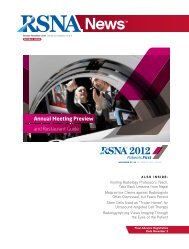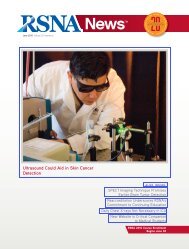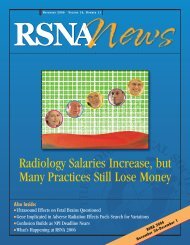RSNA 2009 Meeting Preview - Radiological Society of North America
RSNA 2009 Meeting Preview - Radiological Society of North America
RSNA 2009 Meeting Preview - Radiological Society of North America
Create successful ePaper yourself
Turn your PDF publications into a flip-book with our unique Google optimized e-Paper software.
limitation. “However, since deep endometriosis<br />
is a chronic disease, we don’t<br />
expect this delay to dramatically bias<br />
our results,” she said.<br />
Although Neal C. Dalrymple, M.D.,<br />
a radiologist at South Texas Radiology<br />
Group in San Antonio, said the study<br />
made him optimistic about better diagnosis<br />
<strong>of</strong> deep endometriosis, he agreed<br />
more research is required.<br />
“The surgeons in the study were<br />
aware <strong>of</strong> the depth <strong>of</strong> the disease<br />
because they reviewed the MR findings<br />
before they went into surgery,” said Dr.<br />
Dalrymple, a member <strong>of</strong> the genitourinary<br />
radiology subcommittee <strong>of</strong> the<br />
<strong>RSNA</strong> Scientific Program Committee<br />
and author <strong>of</strong> the book, “Problem Solving<br />
in Abdominal Imaging.”<br />
“I don’t know how feasible it is,<br />
but I’d like to see a future study where<br />
surgeons not currently using MR for<br />
preoperative planning were given MR<br />
results after performing the initial<br />
surgical exploration but before the procedure<br />
was over. That might provide<br />
more insight into the value added by<br />
MR,” he said.<br />
MR Imaging Could Aid Up-Front Diagnosis<br />
Marco A. Amendola, M.D., director<br />
<strong>of</strong> medical imaging at the Innovative<br />
Cancer Institute in Miami, and also a<br />
member <strong>of</strong> the genitourinary radiology<br />
subcommittee <strong>of</strong> the <strong>RSNA</strong> Scien-<br />
tific Program Committee, concurred<br />
with Dr. Dalrymple that preoperative<br />
diagnosis <strong>of</strong> deep endometriosis is<br />
challenging and has so far been more<br />
successful in academic centers than in<br />
community practice.<br />
“Knowledge <strong>of</strong> the precise distribution<br />
and extension <strong>of</strong> endometriosis<br />
is essential for the surgeon,” said Dr.<br />
Amendola. “Excision <strong>of</strong> deep endometriosis<br />
is technically very demanding<br />
and is associated with high surgical risk<br />
including the need for colostomy.”<br />
Because deep endometriosis is<br />
underdiagnosed, Dr. Dalrymple said he<br />
is hopeful that MR imaging will allow<br />
earlier more definitive diagnosis.<br />
“We don’t really know how many<br />
women have deep endometriosis,” he<br />
said. “In my experience, we usually<br />
go searching for deep endometriosis in<br />
women who fail treatment for surface<br />
disease. MR imaging has the potential<br />
to let us diagnose deep endometriosis<br />
up front.”<br />
Additionally, preoperative MR imaging<br />
could help reduce anxiety in patients<br />
and physicians by eliminating some <strong>of</strong><br />
the variables, Dr. Dalrymple added.<br />
“I think it gives both the surgeon and<br />
the patient more confidence to go into<br />
a procedure with a plan, aware <strong>of</strong> the<br />
extent <strong>of</strong> disease preoperatively rather<br />
than discovering it during surgery.” ■<br />
Preoperative MR imaging may help radiologists diagnose deep<br />
endometriosis and more precisely characterize extent <strong>of</strong> disease,<br />
according to a new study in Radiology.<br />
Axial high-spatial-resolution turbo spin-echo T2-weighted flowcompensated<br />
T2-weighted MR images (repetition time, respiratory<br />
period; echo time, 135 msec) in a 21-year-old woman. There is<br />
deep endometriosis infiltrating the right ulterosacral ligaments<br />
(short arrow), pelvic muscle and colon wall (long arrow). Image<br />
shows circumferential rectosigmoid stenosis due to deep endometriosis<br />
(x) visualized after administration <strong>of</strong> intrarectal ultrasonographic<br />
gel (* = rectosigmoid lumen filled with gel). The different<br />
sublayers can be distinguished (arrowhead = mucosa, short straight<br />
arrow = submucosa, curved arrow = muscularis, long straight arrow<br />
= serosa). At MR imaging and pathologic examination, the colon<br />
wall infiltration was graded as involving the mucosa.<br />
Radiology <strong>2009</strong>;253:126–134<br />
Learn More<br />
■ The study, “Endometriosis: Contribution<br />
<strong>of</strong> 3.0-T Pelvic MR Imaging in Preoperative<br />
Assessment—Initial Results,” published in<br />
Radiology online on July 7, is available at<br />
Radiology.<strong>RSNA</strong>.org/content/253/1/126.<br />
More about the study is also available<br />
in the Radiology in Public Focus column on<br />
Page 37.<br />
❚<br />
Genitourinary Session<br />
at <strong>RSNA</strong> <strong>2009</strong><br />
HE REFRESHER COURSE, “Genitourinary<br />
TEmergencies:<br />
Case-based Approach,<br />
An Interactive Session (RC607),” will be<br />
presented on Thursday, Dec. 3, by Syed<br />
Zafar H. Jafri, M.D.,<br />
Courtney A. Woodfield,<br />
M.D., and<br />
Deborah A. Baumgarten,<br />
M.D., M.P.H.<br />
Learning objectives<br />
include recognizing pathology in pregnant<br />
and non-pregnant women, reviewing acute<br />
adnexa features that direct management and<br />
developing an imaging approach, including<br />
MR.<br />
Registration for these and all <strong>RSNA</strong><br />
<strong>2009</strong> courses is under way at <strong>RSNA</strong><strong>2009</strong>.<br />
<strong>RSNA</strong>.org.<br />
<strong>RSNA</strong>NEWS. ORG<br />
<strong>RSNA</strong> NEWS<br />
7






